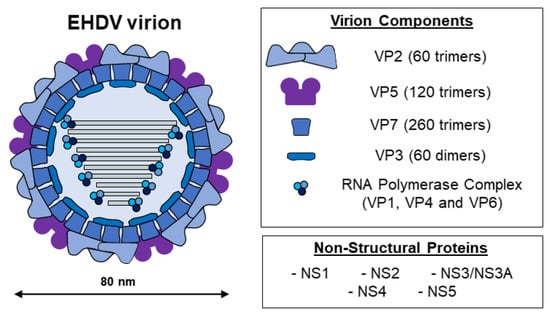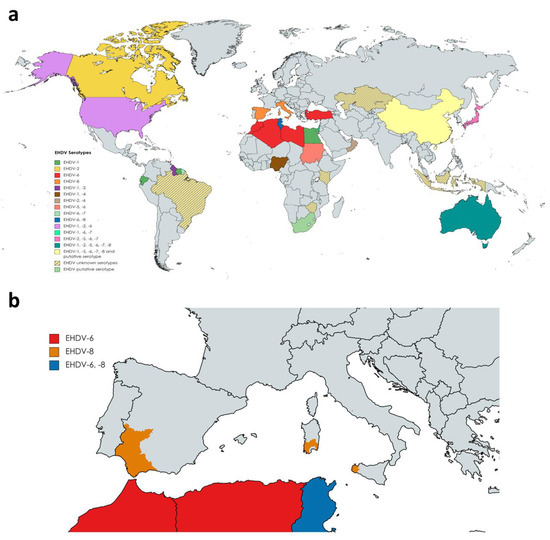During the initial steps of infection, a type I IFN response determines whether the disease makes progress in the infected host. In experimental infection of deer with EHDV, peak viraemia coincided with peak IFN type I levels and both then rapidly declined
[84][118]. Importantly, host genetics related to the innate immune response probably play a role in disease outcome
[85][119]. Leukopenia and lymphopenia are common features of EHD. Clinical outcomes vary depending on the different forms of disease. The sub-acute form is characterized by development of ulcers in the oral cavity and the gastrointestinal tract
[68][102]. The acute forms portrays a hemorrhagic disease that includes hyperaemia of the conjunctiva and the oral mucosa, pulmonary edema, pleural effusion, and multifocal haemorrhages in a variety of organs affected by vascular damage and coagulopathy
[68][102]. The peracute disease causes fulminant death, probably due to the development of pulmonary vascular injury with subsequent pulmonary oedema, probably assocciated with the cytokine storm
[82][116]. Prolonged infections have also been observed in experimentally infected WTD and cattle, which can be explained by association of EHDV viral particles with invaginations in the erythrocyte membrane
[86][120].
5. Experimental Animal Models of EHDV
5.1. White-Tailed Deer (WTD) and Other Cervid Species
As the global incidence of EHD is constantly increasing, the study of pathogenesis, transmission, and diagnosis as well as the evaluation of vaccine candidates in natural wildlife hosts is a key issue. In this sense, cervids have been used for EHDV study in natural hosts
(Table 1). Different species of cervids, including red, fallow, roe, and muntjac deer, were experimentally infected with the New Jersey strain of EHDV-1, which is highly virulent in WTD. In contrast, these animals did not display any signs of disease, although productive infection could be detected
[87][123]. Among the species of cervids susceptible to EHDV infection, WTD stand out as the most affected host of EHDV. Experimental infection of WTD with EHDV followed the first outbreak detected in the USA. WTD inoculated with EHDV-1 displayed severe illness in most cases, resembling the clinical disease observed in nature and displaying gross and histopathological lesions
[88][89][124,125]. A high mortality among infected WTD was recorded
[89][125]. In general, experimental infection of WTD with EHDV induces acute disease leading to high mortality rates, independent from the age or sex of the infected animals. WTD infected with the reassortant North American EHDV-6 resembled infection and clinical disease caused by the US strains of EHDV-1 and EHDV-2. Researchers also characterized virological parameters of EHDV infection, detecting viraemia from the third day post-inoculation until more than two weeks later (viraemia was detectable for more than seven weeks) in surviving animals, even in presence of high nAb titers. Viral RNA was detected in tissue samples of organs that presented macro- and microscopic lesions
[90][126]. A field isolate of EHDV-7 that caused intense and widespread epizootic in domestic cattle in Israel was also assessed to determine whether WTD was susceptible to infection. This virus strain led to a clinical disease identical to that observed in experimental infections with North American isolates, and virological parameters were similar to those of EHDV-6 infected WTD
[91][127]. The fact that “exotic” strains of EHDV can productively infect WTD inducing fatal clinical disease highlights the marked susceptibility of WTD to EHDV infection. Nonetheless, it is important to note that not all subspecies of WTD share the same susceptibility grade, with some of them, such as the subspecies
Odocoileus virginianus texanus (which inhabits regions where EDHV has been endemic for a long period), showing innate resistance to EHDV
[92][128]. Differential expression of pro-inflammatory cytokines could explain this resistance
[81][115]. Host genetic factors can also influence susceptibility to EHDV infection
[85][119]. This illustrates the complexity of understanding the pathogenesis and virulence of EHDV even in WTD.
5.2. Cattle and Other Farm Animals
WTD and other wildlife experimental models involve limitations (reviewed in
[93][138]) that are not shared by suitable traditional livestock experimental animals widely used in infectious disease research. As stated above, during recent EHDV outbreaks in North America, the Mediterranean Basin, and Reunion Island, an apparent increase in pathogenicity of EHDV in cattle raised concerns. Therefore, cattle can be considered as a more accessible and cheaper alternative to WTD for studying viral pathology and evaluating vaccine efficacy. In later studies, cattle, sheep, pigs, and goats were inoculated with the New Jersey strain of EHDV-1, which was virulent in deer
[87][123]. Despite technical limitations concomitant with that time, researchers were able to observe viraemia in inoculated sheep and cattle while none of the goats or pigs were viraemic. Interestingly, the virus was recovered from the vulva of a recently lambed viraemic sheep. Clinical disease was not observed in any animal
[87][123]. Similarly, other researchers observed that inoculation of cattle with the EHDV-1 New Jersey strain did not induce clinical disease, but the virus could be isolated from day 9 to day 23 post-inoculation and viraemia was detected by gel-based reverse transcriptase-PCR between days 3 and 28 post-infection. Similar results were observed for cattle infected with the Alberta strain of EHDV-2
[94][139]. In another work, subsequent inoculation of cattle with two US isolates led to transient viraemia as well as the induction of a neutralizing immune response in absence of clinical disease
[95][140].
5.3. Mouse Models
Availability of appropriate laboratory animal models is a major concern when studying disease pathogenesis and developing efficient and safe therapies against viral diseases. Mouse models are a reliable tool that reproduce or, at least, partially mimic the disease pathogenesis in a variety of cases
[96][148]. For vaccine development, utilization of valid mouse models endorses the basis of every traditional vaccine development procedure as it implies several advantages, such as reduction of costs and time, facility to handle and accessibility of a huge number of optimal reagents. When considering vaccine evaluation against veterinary diseases, mouse models offer a more accessible and affordable animal housing compared to natural hosts. Immunocompromised mouse models, like mice deficient in the type I IFN (IFN-α/β) receptor (IFNAR(−/−)), have been extensively used for vaccine efficacy assessment. The IFNAR(−/−) knock-out receptor mouse model has been employed to study viral infection, disease, pathogenesis and vaccine testing against a plethora of viral diseases
[96][148]. This laboratory animal model has been exploited for extensive study of BTV and AHSV
[97][98][99][149,150,151]. Infection of IFNAR(−/−) mice with BTV and AHSV reproduces the pathology observed in natural hosts of these viruses.
6. Classic and Novel Vaccine Approaches against EHDV
Vaccination entails the most effective countermeasure to successfully contain several human and veterinary viral diseases. In the case of EHDV, vaccines based on conventional approaches have been developed and their commercialization has been circumscribed to regions where the virus has circulated causing a significant economic impact. In Japan, two vaccines against EHDV-2 are commercially available: a monovalent live attenuated vaccine and an inactivated bivalent vaccine (against EHDV-2 and bovine ephemeral fever, caused by bovine ephemeral fever virus).
LAVs (live attenuated vaccines) against BTV are used in the United States, Turkey, the Republic of South Africa, India, and Israel, among others
[100][161]. However, BTV LAVs, which show highly immunogenicity, are often associated with several drawbacks relating toanimal welfare and transmission to insect vectors (reviewed elsewhere
[100][161]). For these reasons, and after being used to control several outbreaks of BTV over the years, immunization with BTV LAVs was reduced and, eventually, completely substituted by inactivated vaccines in the European Union (EU)
[101][162]. Therefore, LAVs are not a recommended choice to consider in EHDV vaccination campaigns in the EU, as the possibility of virus spillover to unaffected regions through uptake and spread by midges or in-contact transmission is clear. Inactivated vaccines against BTV are produced and licensed in Europe, and, although some pitfalls exist (reviewed in
[101][162]), this approach has demonstrated more than enough efficacy to control this disease
[101][162].
Next-generation vaccines against EHDV must overcome inherent disadvantages of classical approaches that occur with BTV and AHSV. First, they must allow differentiation between naturally infected and vaccinated animals (DIVA), which has fundamental implications in the economic field. Second, these newly generated vaccines should induce protection against multiple EHDV serotypes, whose expansion to non-endemic latitudes is highly probable. To date, the unique vaccine candidate that has been evaluated is based on recombinant VP2 protein of EHDV-2
[102][164]. This DIVA subunit vaccine has shown promising results in terms of immunogenicity and protection in the primarily EHDV affected host, WTD, preventing it from EHDV clinical disease, infection, and viraemia. Prime-boost immunization with rVP2 of serotype 2 induced high titers (ranging from 1:240 to 1:320) of homologous nAbs in immunized WTD. After viral challenge with virulent EHDV-2, immunized animals did not display EHD-related signs of disease and showed steady rectal temperatures and peripheral lymphocyte counts. No viraemia nor RNA were detected in EHDV-target organs, and immunized WTD showed an absence of gross and histopathological lesions. Although not yet evaluated, its efficacy for avoiding transmission to the insect vector seems plausible as no RNA was detected in blood. This EHDV-2 rVP2-based vaccine is currently under field trial in the USA. Importantly, cattle immunized following the same immunization strategy also developed a potent humoral response. Not only that, but the authors also achieved the expression and purification of the rVP2 of EHDV-6, which induced high titers of homologous nAbs in cattle. In this sense, bi- or multivalent vaccines could be formulated as proposed in the study
[102][164]. Different vaccine platforms widely used for novel BTV and AHSV vaccines
[103][104][152,165] should be applied for generation of novel EHDV vaccines, e.g., subunit vaccine and viral vector-based vaccines.
7. Conclusions
EHDV, an important arthropod-transmitted RNA virus that infects different wild and domestic ruminants, has experienced a northern spread into novel areas in the last 20 years. Global warming may result in expansion of vector species to previously vector-free regions, and in altered vector competence of some midge species. These factors and others related with human activities are likely to increase the risk of EHDV outbreaks in new territories. Worryingly, the virus has recently been detected for the first time in the European Union in October 2022.
White-tailed deer are especially susceptible to severe illness caused by EHDV infection; nevertheless, disease can also occur in bovines. The increased virulence of certain EHDV strains observed in cattle and the expansion of competent vectors involved in EHDV transmission make necessary further investigation regarding the development of new diagnostic techniques, safe DIVA vaccines, and the evaluation of laboratory animal models that will facilitate the study of the protective capacity of new vaccine candidates against EHDV.


